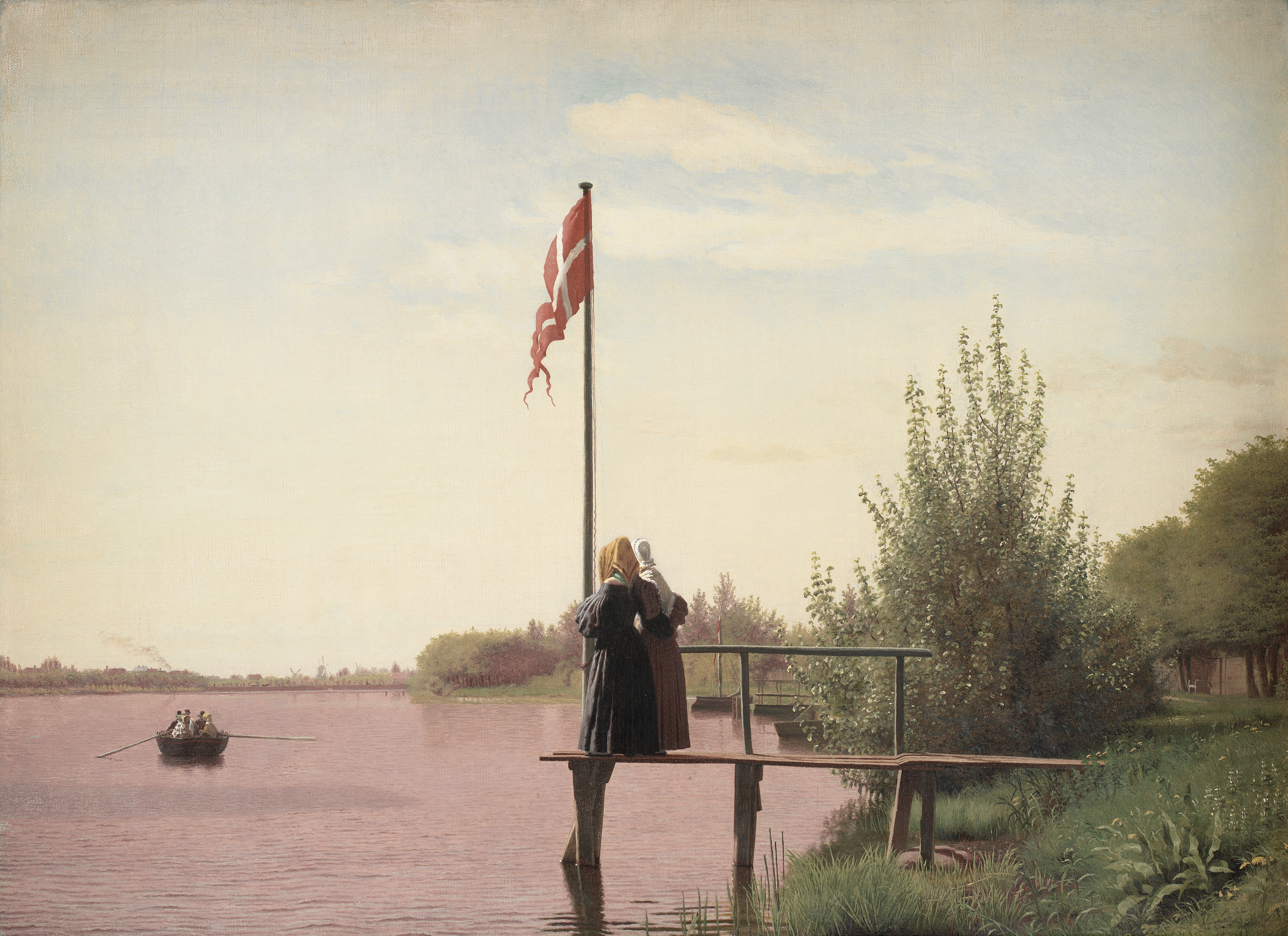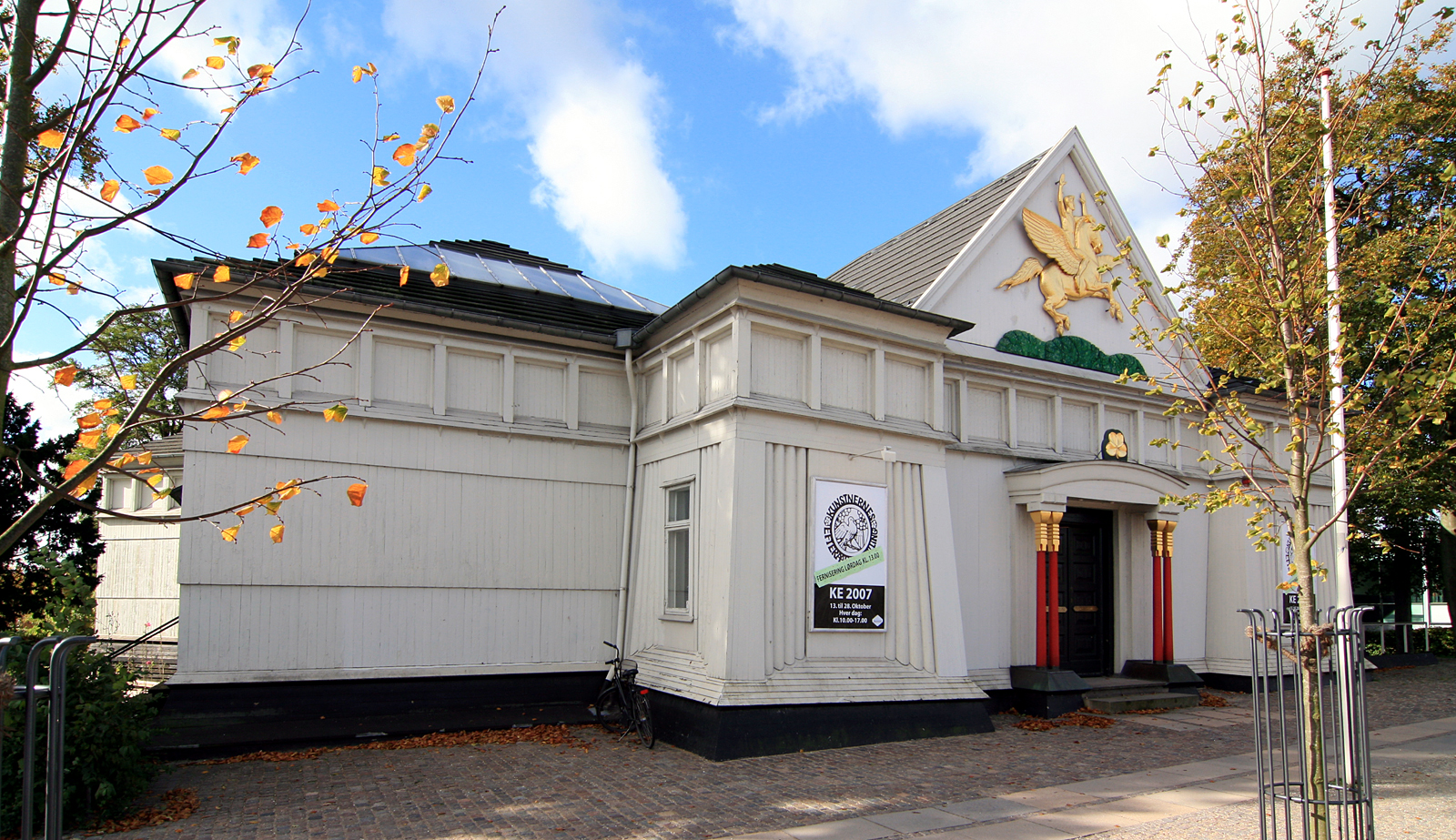|
Kaj Ejstrup
Kaj Ejstrup (20 February 1902 – 23 November 1956) was a Danish artist, illustrator and sculptor. Above all, he is remembered for the landscapes he painted in the north west of Zealand as a member of the artists' colony known as the Odsherred Painters. In 1932, he was one of the founding members of the Corner artists association. Much of his work can be seen at Odsherreds Museum of Art. Biography The adopted son of a customs official, Ejstrup was brought up in Buddinge, north of Copenhagen. A self-taught painter, he was unsuccessful in gaining admission to the Royal Danish Academy of Fine Arts but learnt wood engraving under Aksel Jørgensen in various periods from 1931 to 1937. He debuted in 1926 at the Kunstnernes Efterårsudstilling (Artists' Autumn Exhibition) and was a founding member of the Corner exhibition in 1932. In 1930, he settled in Åsen near Ordrup in Odsherred together with Karl Bovin and later bought an old homestead near Skamlebæk where he lived until 1944. Th ... [...More Info...] [...Related Items...] OR: [Wikipedia] [Google] [Baidu] |
Art Of Denmark
Danish art is the visual arts produced in Denmark or by Danish artists. It goes back thousands of years with significant artifacts from the 2nd millennium BC, such as the Trundholm sun chariot. For many early periods, it is usually considered as part of the wider Nordic art of Scandinavia. Art from what is today Denmark forms part of the art of the Nordic Bronze Age, and then Norse art, Norse and Viking art. Danish medieval painting is almost entirely known from church frescos in Denmark, church frescos such as those from the 16th-century artist known as the Elmelunde Master. The Reformation greatly disrupted Danish artistic traditions, and left the existing body of painters and sculptors without large markets. The requirements of the court and aristocracy were mainly for portraits, usually by imported artists, and it was not until the 18th century that large numbers of Danes were trained in contemporary styles. For an extended period of time thereafter art in Denmark either ... [...More Info...] [...Related Items...] OR: [Wikipedia] [Google] [Baidu] |
Odsherred
Odsherred is a peninsula in the north-western part of the island Zealand (Sjælland) in Denmark. Odsherred stretches from the Sjællands Odde in the north-west to the now drained Lammefjord in the south, covering an area with a wide range of the most typical Danish landscapes: long sandy beaches, small rolling hills and farming. The peninsula is served by the railway Odsherredsbanen, which runs through the most important towns, including Nykøbing Sjælland, Asnæs and Hørve. History The last part of the name ''herred'' derives from a medieval practice of dividing the country in districts ''herreder'' which created the frame for regional justice and possibly also for recruitment of soldiers to the national army and fleet. They roughly correspond to today's counties. Odsherred was only one out of many of such ''herreder'', since every part of the country was also a part of a ''herred''. After the administrative importance of the ''herreder'' ended in 1919, the once common name b ... [...More Info...] [...Related Items...] OR: [Wikipedia] [Google] [Baidu] |
1956 Deaths
Events January * January 1 – The Anglo-Egyptian Sudan, Anglo-Egyptian Condominium ends in Sudan. * January 8 – Operation Auca: Five U.S. evangelical Christian Missionary, missionaries, Nate Saint, Roger Youderian, Ed McCully, Jim Elliot and Pete Fleming, are killed for trespassing by the Huaorani people of Ecuador, shortly after making contact with them. * January 16 – Egyptian leader Gamal Abdel Nasser vows to reconquer Palestine (region), Palestine. * January 25–January 26, 26 – Finnish troops reoccupy Porkkala, after Soviet Union, Soviet troops vacate its military base. Civilians can return February 4. * January 26 – The 1956 Winter Olympics open in Cortina d'Ampezzo, Italy. February * February 11 – British Espionage, spies Guy Burgess and Donald Maclean (spy), Donald Maclean resurface in the Soviet Union, after being missing for 5 years. * February 14–February 25, 25 – The 20th Congress of the Communist Party of the Soviet Union is held in Mosc ... [...More Info...] [...Related Items...] OR: [Wikipedia] [Google] [Baidu] |
1902 Births
Nineteen or 19 may refer to: * 19 (number), the natural number following 18 and preceding 20 * one of the years 19 BC, AD 19, 1919, 2019 Films * ''19'' (film), a 2001 Japanese film * ''Nineteen'' (film), a 1987 science fiction film Music * 19 (band), a Japanese pop music duo Albums * ''19'' (Adele album), 2008 * ''19'', a 2003 album by Alsou * ''19'', a 2006 album by Evan Yo * ''19'', a 2018 album by MHD * ''19'', one half of the double album ''63/19'' by Kool A.D. * ''Number Nineteen'', a 1971 album by American jazz pianist Mal Waldron * ''XIX'' (EP), a 2019 EP by 1the9 Songs * "19" (song), a 1985 song by British musician Paul Hardcastle. * "Nineteen", a song by Bad4Good from the 1992 album '' Refugee'' * "Nineteen", a song by Karma to Burn from the 2001 album ''Almost Heathen''. * "Nineteen" (song), a 2007 song by American singer Billy Ray Cyrus. * "Nineteen", a song by Tegan and Sara from the 2007 album '' The Con''. * "XIX" (song), a 2014 song by Slipkn ... [...More Info...] [...Related Items...] OR: [Wikipedia] [Google] [Baidu] |
Eckersberg Medal
The Eckersberg Medal (originally the ''Akademiets Aarsmedaille'' or Annual Academy Medal) is an annual award of the Royal Danish Academy of Fine Arts. It is named after Christoffer Wilhelm Eckersberg, known as the father of Danish painting. The Eckersberg Medal was created in 1883, on the 100th birthday of its namesake. Eckersberg Medal recipients Source (1940 onwards)Akademiraadet 1880s 1890s 1900s 1910s 1920s 1930s 1940s 1950s 1960s *1960: Ejler Bille, Sven Havsteen-Mikkelsen, Henry Luckow-Nielsen *1961: Flemming Bergsøe, Jørgen Andersen Nærum *1962: Preben Hornung, Svend Engelund *1963: Anna Klindt Sørensen, Jeppe Vontillius *1964: Albert Mertz, Sig. Vasegaard *1965: Frede Christoffersen, Reidar Magnus, Erik Thommesen *1966: Søren Georg Jensen,Jensen Silver, The Georg Jensen Designers, http://www.jensensilver.com/news-info/designers.html (retrieved December 2008) Poul Bjørklund *1967: Poul Ekelund, Erling Frederiksen, Agnete Varming, Gunnar Westman *1968 ... [...More Info...] [...Related Items...] OR: [Wikipedia] [Google] [Baidu] |
Statens Museum For Kunst
The National Gallery of Denmark ( da, Statens Museum for Kunst, also known as "SMK", literally State Museum for Art) is the Danish national gallery, located in the centre of Copenhagen. The museum collects, registers, maintains, researches and handles Danish and foreign art dating from the 14th century to the present day. Collections The museum's collections constitute almost 9,000 paintings and sculptures, approximately 240,000 works of art on paper as well as more than 2,600 plaster casts of figures from ancient times, the middle-ages and the Renaissance. Most of the older objects come from the Danish royal collection. Approximately 40,000 pieces from the collections are expected to be made available online by 2020. European Art 1300–1800 The display of European Art 1300–1800 is a comprehensive collection of art over the 500-year period, featuring works by Mantegna, Cranach, Titian, Rubens and Rembrandt. The art is spread over thirteen rooms, and is the oldest ... [...More Info...] [...Related Items...] OR: [Wikipedia] [Google] [Baidu] |
Karl Bovin
Karl (Kalle) Christian Bovin (1907–1985) was a Danish painter whose work focused on landscapes of Odsherred, a region in the north-west of Zealand. In the 1930s, he became a central member in the Odsherred Painters artists' colony and helped to found the Corner artists association. Biography Bovin was born in Frederikshavn, as the eldest son of a stone mason. From an early age, he was interested in art. In the 1920s, he cycled to the artists paradise Skagen in the north of Jutland to show his early works to Anna and Michael Ancher. At their encouragement, he attended the Royal Danish Academy of Art in Copenhagen from 1928 to 1931, where he studied under Sigurd Wandel and Aksel Jørgensen. During his time at school, he associated with a group of constructivists who relied on intuition and observation, but eventually expressed dissatisfaction with their approach to art. He therefore joined fellow artist Kaj Ejstrup in Odsherred to concentrate on nature and landscape painting. ... [...More Info...] [...Related Items...] OR: [Wikipedia] [Google] [Baidu] |
Kunstnernes Efterårsudstilling
Den Frie Udstilling ('The Free Exhibition') is a Danish artists' association, founded in 1891 by artists in protest against the admission requirements for the Kunsthal Charlottenborg. Modeled on the Salon des Refusés, it is Denmark's oldest association of artists. Now located on Copenhagen's Oslo Plads next to Østerport Station, it works as an arts centre, continuing to exhibit works created and selected by contemporary artists rather than those chosen by cultural authorities. History The organization was initiated by the painter Johan Rohde (1856–1935) and included several founding members: Jens Ferdinand Willumsen, Anne Marie Carl-Nielsen, Vilhelm Hammershøi, Johanne Cathrine Krebs, the couple Harald and Agnes Slott-Møller, Christian Mourier-Petersen and Malthe Engelsted. The first exhibition in 1891 presented 100 works by 18 artists, including Peder Severin Krøyer, Julius Paulsen and Kristian Zahrtmann, who were among Denmark's greatest painters of the period. [...More Info...] [...Related Items...] OR: [Wikipedia] [Google] [Baidu] |
Zealand
Zealand ( da, Sjælland ) at 7,031 km2 is the largest and most populous island in Denmark proper (thus excluding Greenland and Disko Island, which are larger in size). Zealand had a population of 2,319,705 on 1 January 2020. It is the 13th-largest island in Europe by area and the 4th most populous. It is connected to Sprogø and Funen by the Great Belt Fixed Link and to Amager by several bridges in Copenhagen. Indirectly, through the island of Amager and the Øresund Bridge, it is also linked to Scania in Sweden. In the south, the Storstrøm Bridge and the Farø Bridges connect it to Falster, and beyond that island to Lolland, from where the Fehmarnbelt Tunnel to Germany is planned. Copenhagen, the capital of Denmark, with a population between 1.3 and 1.4 million people in 2020, is located mostly on the eastern shore of Zealand and partly on the island of Amager. Other cities on Zealand include Roskilde, Hillerød, Næstved, Helsingør, Slagelse, Køge, Holbæk a ... [...More Info...] [...Related Items...] OR: [Wikipedia] [Google] [Baidu] |
Aksel Jørgensen
Aksel Jørgensen (3 February 1883 – 9 June 1957) was a Denmark, Danish painter and Wood engraving, wood engraver. He is also remembered for his years as the director and professor at the Royal Danish Academy of Fine Arts, Royal Danish Academy where he instructed many Danish illustrators."Aksel Jørgensen" ''Den Store Danske''. Retrieved 21 February 2013. Childhood Aksel Jørgensen was born in Copenhagen. His parents were the mechanic Mathias Jørgensen and Maren née Christensen. Aksel later described his parents' home as very modest but harmonious. Like many working-class families of the time, the family lived in a very small space in a two-room apartment without sanitary facilities. At the age of four, Jørgensen became seriously ill with an otitis media, the ...[...More Info...] [...Related Items...] OR: [Wikipedia] [Google] [Baidu] |
Wood Engraving
Wood engraving is a printmaking technique, in which an artist works an image or ''matrix'' of images into a block of wood. Functionally a variety of woodcut, it uses relief printing, where the artist applies ink to the face of the block and prints using relatively low pressure. By contrast, ordinary engraving, like etching, uses a metal plate for the matrix, and is printed by the intaglio method, where the ink fills the ''valleys'', the removed areas. As a result, wood engravings deteriorate less quickly than copper-plate engravings, and have a distinctive white-on-black character. Thomas Bewick developed the wood engraving technique in Great Britain at the end of the 18th century. His work differed from earlier woodcuts in two key ways. First, rather than using woodcarving tools such as knives, Bewick used an engraver's burin (graver). With this, he could create thin delicate lines, often creating large dark areas in the composition. Second, wood engraving traditionally use ... [...More Info...] [...Related Items...] OR: [Wikipedia] [Google] [Baidu] |




